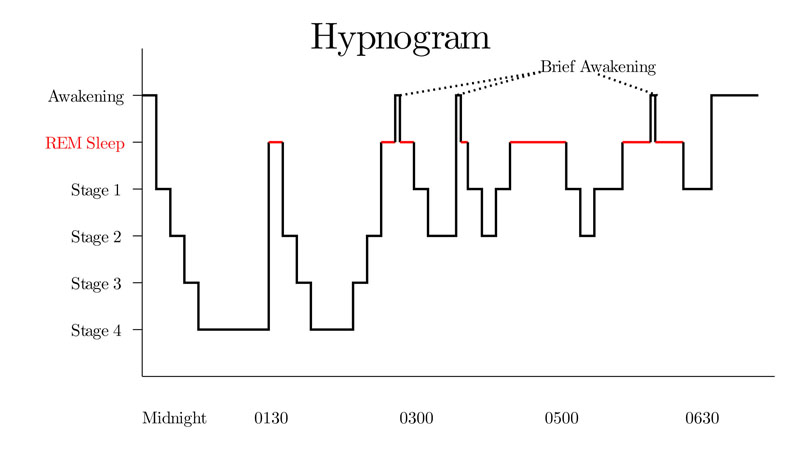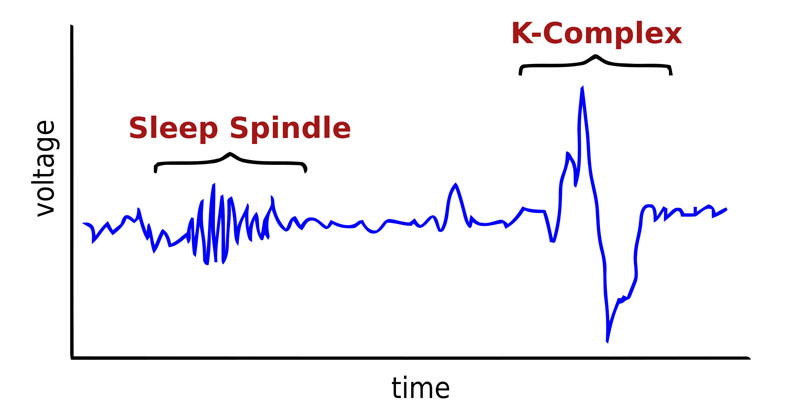Stages of Sleep
- Electroencephalography is an electrophysiological monitoring method to record electrical activity of the brain, measuring voltage fluctuations resulting from ionic current within the neurons of the brain. It is typically noninvasive.
- Electrooculography is a technique for measuring the corneo-retinal standing potential that exists between the front and the back of the human eye. Primary applications are in ophthalmological diagnosis and in recording eye movements.
- Electromyography is an electrodiagnostic medicine technique for evaluating and recording the electrical activity produced by skeletal muscles.
- Neural oscillation is rhythmic or repetitive neural activity in the central nervous system.
- A gamma wave (30-100 Hz) is a pattern of neural oscillation. These types of brain waves seem to be implicated in creating the unity of conscious perception (the binding problem) during conscious awake states and dreaming.
- Low amplitude beta waves (13-30 Hz) with multiple and varying frequencies are often associated with active, busy, or anxious thinking and active concentration.
- Alpha waves (8-13 Hz) are a type of brain waves which predominantly originate from the occipital lobe during wakeful relaxation with closed eyes. These brain waves are reduced with open eyes, drowsiness and sleep.
- Cortical theta waves (4-8 Hz) are observed frequently in young children. In older children and adults, they tend to appear during meditative, drowsy, or sleeping states, but not during the deepest stages of sleep.
- A delta wave (1-4 Hz) is a high amplitude, low frequency brain wave. These types of brain waves are usually associated with the deep stage 3 of non-REM sleep, also known as slow-wave sleep.
- Hypnagogia is the experience of the transitional state from wakefulness to sleep.
- Non-REM sleep is collectively sleep stages 1-3. There are distinct electroencephalographic and other characteristics seen in each stage. There is usually little or no eye movement during these stages. Dreaming is rare and muscles are not paralyzed.
- Stage 1 sleep usually occurs between sleep and wakefulness, and sometimes between periods of deeper sleep and periods of REM. The brain transitions from alpha waves to theta waves. Sudden twitches and hypnic jerks may be associated sleep onset. Some people may also experience hypnagogic hallucinations during this stage.
- In stage 2 sleep, theta activity is observed and sleepers become gradually harder to awaken; the alpha waves of the previous stage are interrupted by abrupt activity called sleep spindles and K-complexes.
- A sleep spindle is a burst of oscillatory brain activity visible on an EEG that occurs during stage 2 sleep. It consists of 12-14 Hz waves generated in the reticular nucleus of the thalamus that occur for at least 0.5 seconds.
- K-complexes are EEG waveformss that occur during stage 2 of NREM sleep, the largest events in healthy human EEG. More frequent in the first sleep cycles, they are thought to suppress cortical arousal in response to stimuli evaluated not to signal danger and also to aid sleep-based memory consolidation.
- Stage 3 sleep is slow-wave, deep sleep. Consisting of delta activity, it is thought to be the most restful form of sleep in which the sleeper is less responsive to the environment. This is the stage in which night terrors, nocturnal enuresis, sleepwalking, and somniloquy occur.
- During REM sleep, most muscles are paralyzed, and heart rate, breathing and body temperature become unregulated, and the sleeper may experience vivid dreams. Although exhibiting high-frequency EEG waves similar to a waking state, the sleeper is harder to arouse than at any other sleep stage.
- REM rebound is the lengthening and increasing frequency and depth of rapid eye movement (REM) sleep which occurs after periods of sleep deprivation.
- REM behavior disorder is a sleep disorder that involves abnormal behavior during the sleep phase with REM sleep. The major abnormal feature of this disorder is loss of muscle atonia during otherwise intact REM sleep.






